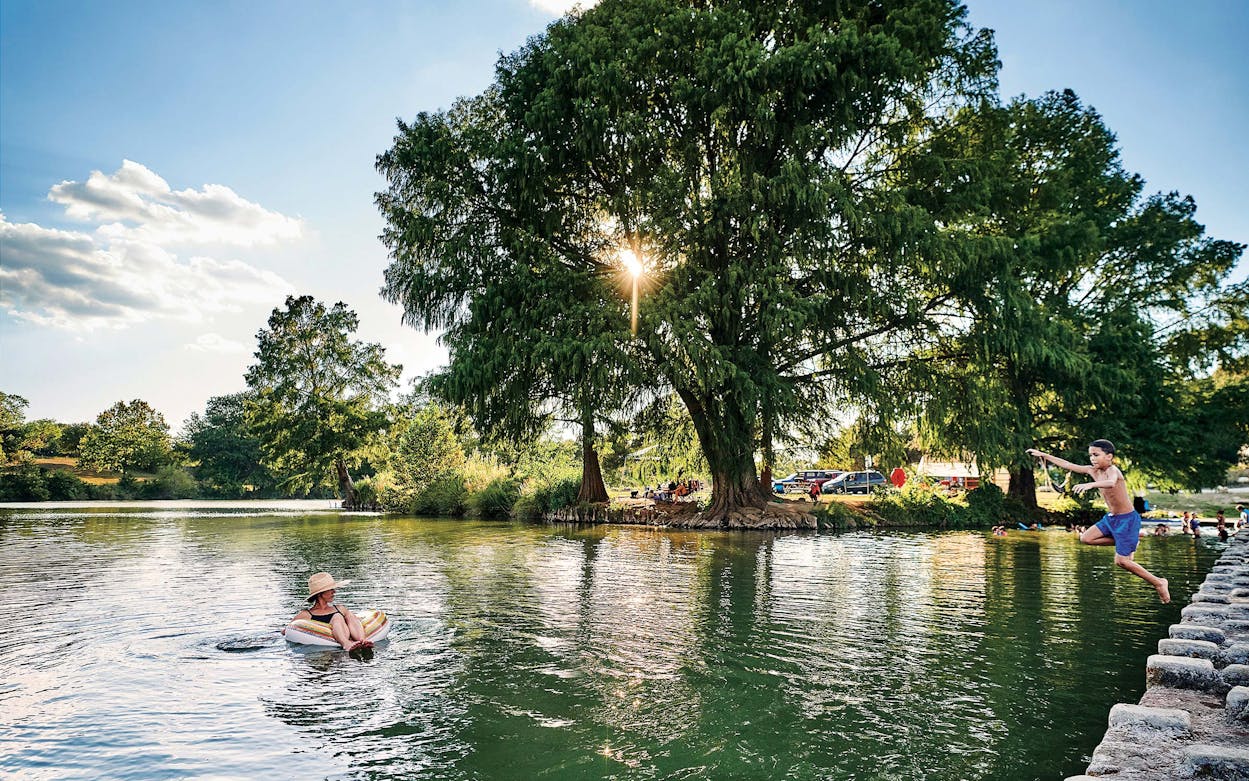A couple of friends and I float in the shade of an enormous bald cypress, our feet propped on the mossy top of the stair-step dam, undeterred by the stillness of the water, the two slender snakes we’ve seen slithering across it, or the possible presence of the rare-but-almost-always-fatal-when-snorted Naegleria fowleri amoeba. It’s late August at Blanco State Park, and the stretch of river above the main dam, part of an area known as the Falls (which is what it looks like when the water is running), is a green, lakelike expanse too slow-moving for tubing but perfect for floating and long-distance swimming. We watch families arriving early to stake their claim to picnic tables, and we laugh at a group of young boys jumping from the dam and taunting one another. “That wasn’t a 360; that was a 180 belly flop!” yells one. Another, about to dive into the middle of an inner tube, boasts, “If I make it through the hole, I get to punch you in the face!” Kids these days.
If not for the U.S. 281 bridge, which ferries a noisy parade of cars and motorcycles and semitrucks across the Blanco River, Blanco State Park would be a perfect little pocket of water-lapped, tree-shaded refuge. Established by the Legislature in 1933, from a combination of donated and purchased land, one of Texas’s first state parks feels more like a large city park; located just a few blocks from the square, it’s completely contained within the Hill Country town of Blanco. A compact 105 acres, it’s quite manageable, which is a plus for visitors, like me and my pals, who feel they have to drive every winding road, walk every trail (BSP has exactly two), and see every last historic structure.
As for the structures found in this park, most of them were built in just one year, from June 1933 to May 1934, when Company 854 of the Civilian Conservation Corps swooped in and efficiently completed roads, bridges, two dams, and the limestone-and-timber open-air pavilion, a riverbank setting that still hosts all kinds of festive gatherings. Hand-annotated black and white photographs of the “CCC boys at work” illustrate the informational signs placed here and there throughout the property.


The namesake and crown jewel of the park, the Blanco River, runs a mostly shallow, usually tranquil course from its headwaters in the Middle Trinity Aquifer to its meeting with the San Marcos River, 87 miles later. It travels above- and below ground, which explains why some stretches of riverbed are awash in water and others are bone-dry. When the river is moving and the sun is illuminating the swirls and eddies of blue and green and yellow so clear you can see right down to the limestone bottom, you understand why members of an eighteenth-century Spanish expedition gave it the name Blanco (even if we Texans do pronounce it “Blank-oh”).
Sycamores, cottonwoods, and pecan trees link branches over a small campground uphill from the Falls, with screened shelters wired for electricity (they book up a year in advance) and sites for RVs and tents. Egyptian geese and Muscovy ducks waddle around like they own the place, fish splash about, and turtles—red-eared sliders, spiny softshells, river cooters—quietly slip off partly submerged tree branches. (How, with my juvenile sense of humor, did I just now learn that there are turtles called river cooters?)
Swimming, floating, cannonballing, and kayaking are the main water activities, along with fishing for bass, catfish, and sunfish; winter brings the stocking of rainbow trout, unceremoniously expelled from tubes and nets by Texas Parks and Wildlife staff. Walkers have two easy trails to explore, one of which passes by an under-construction birdwatching shelter (we saw many little specimens flitting about) and leads to the remnants of a stone pump house. The other, the Caswell Nature Trail, makes a short loop through the trees along the southeastern bank of the river. The path’s name is a reminder of one of the many challenges the petite park has encountered in its 85 years: in the sixties, when neglect and low attendance threatened its existence, local residents stepped up and saved the day. In his book 100 Classic Hikes in Texas, E. Dan Klepper, a fine-art photographer based in Marathon, writes, “Ira Caswell agreed to manage the park for a small salary of $210 per month. Caswell then employed a hired hand, paying him the $210, and together they set about making repairs to the park’s infrastructure.”
Incidentally, it was also Blanco residents doing it for themselves that preserved the crown jewel of the town itself, the Old Blanco County Courthouse. Completed in 1886, the big, beautiful Second Empire–style structure enjoyed its time as a courthouse for only four years, thanks to a contentious election that moved the county seat to Johnson City. The move did not go over well in Blanco, needless to say. Inside the courthouse is a satiric drawing from the early 1890s, found in 1977 in what used to be a livery stable on the square, of the building being hauled away atop an ox-driven wagon; among the many notations alongside the illustration is “Go, though cursed with thy ill-gotten gains.” But the old gal made out okay, as subsequent years saw her serving as a hospital, school, museum, and, later, backdrop for Hollywood productions, like 2010’s True Grit. She even survived a takeover attempt in the eighties, barely escaping being sold, dismantled, and relocated to a private ranch. The road to her salvation began, as so many of these things do, with a handful of determined women and a bake sale.
Austin and San Antonio (where I and my fellow travelers reside) are each about an hour away from Blanco State Park, and they encroach bit by bit, a fact the locals waste no time informing you of. “Oh, you live in that northern suburb of Blanco!” said one. Of course, many of them are refugees from those same cities (which could explain the half-dozen “Beto for Senate” yard signs, exactly six more than we expected to see). As with many small Texas towns, the line between good growth and bad, positive change and negative, is exceedingly fine. The park and its surrounds are a microcosm of the perennial friction that plays out across the state, what with water wars and traffic woes and hotly contested property battles, almost always won by millionaires, some of whom then set about stringing fences across the riverbed (the line separating what some consider public waterways and others consider private is about the width of barbed wire and just as injurious). Not that nature itself doesn’t rain down its own brand of chaos, as this place and its people witnessed in May 2015, when the typically placid Blanco River became a roiling, debris-filled torrent that took lives and livelihoods and much of the riverbank along with it. The water rose thirty feet, coming right up to the bottom of that 281 bridge.

Feast for Fifty
More for a banquet than a picnic, the CCC-built table at the western edge of the park has a concrete top that spans an impressive seventy feet, with stone benches, a stone firepit, and a river view. For $20 a day, you—and 49 of your friends—can have it.
But the little park that could carries on, withstanding the perpetual lack of funding that plagues the state’s parks in general (BSP found itself on the short list for closure yet again in 2011) and enduring the inevitable cycles of decline and renewal. The river will expand and contract. Bald cypresses will turn orange, then bald, then green again. Receding floodwaters will reveal a riverbed imprinted with the baby-pool-size tracks of a sauropod.
And kids will be kids. As a couple of us walked around the park in the late afternoon, the sun filtering through the tree canopy, the cicadas screeching, and the aroma of propane-fueled dinners wafting through the air (there’s a burn ban, alas), three preteen boys came careering down the narrow road on bicycles. The sight of them conjured up our own sweat-soaked, burger-scented memories of childhood state park adventures—until one called out something to my friend about her being “hot,” and not in a sun-induced way. Another yelled over his shoulder, “Sorry about that!”
We were sorry the next morning, when I discovered I had a dead battery just as we were departing, in separate cars, for Austin. Neither I nor my hot friend had ever used jumper cables (which I happened to have in my trunk only because my dad had put them there years ago), and the rest of our party had already left. So we spent forty minutes hemming and hawing, sweating and fighting mosquitoes, googling and reading car manuals, debating the merits of calling AAA or hailing a park ranger or a post-service churchgoer, anticipating explosions and grass fires and possible disfigurement, and then we finally jumped the damn car ourselves, which took all of four minutes. Go ahead and laugh, but I like to think we were emboldened by that Blanco get-’er-done spirit.
- More About:
- Parks & Recs
- Blanco









